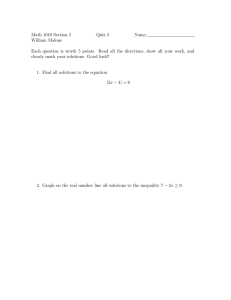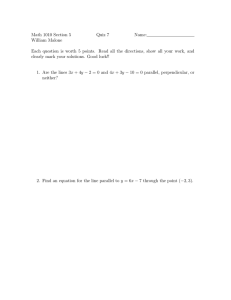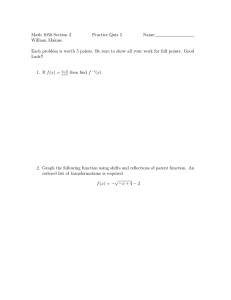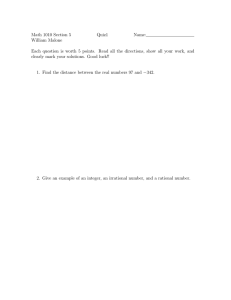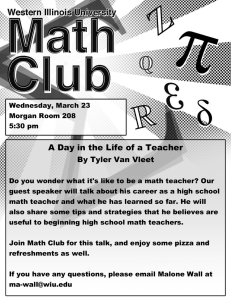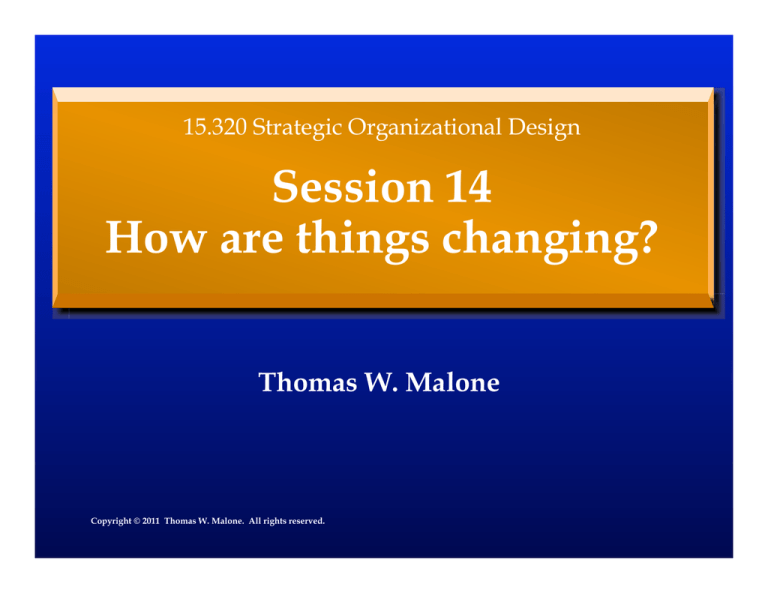
15.320 Strategic Organizational Design
Session 14
How are things changing?
Thomas W. Malone
Copyright © 2011 Thomas W. Malone. All rights reserved.
Two key messages of this course
•!There are patterns in organizational
design.
•!Organizational design is changing.
Copyright © 2011 Thomas W. Malone. All rights reserved.
Outline
•!Quick review
–! Organizational design patterns for hierarchies
•!How are things changing?
–! Organizational design patterns for crowds
Copyright © 2011 Thomas W. Malone. All rights reserved.
Elements of organizational patterns
Strategy
What
Staffing
Who
Why
Incentives
How
Structure
Process
Copyright © 2011 Thomas W. Malone. All rights reserved.
How can activities be grouped?
Functional Organization
Geographical Organization
CEO
Engineering
Marketing
CEO
Manufacturing
Product Organization
Eastern US
Western US
Canada
Matrix Organization
CEO
CEO
Marketing
Product 1
Product 2
Product 3
Copyright © 2007 Thomas Malone. Adapted from David Nadler & Michael Tushman,
Strategic Organization Design (Glenview, IL: Scott Foresman, 1988), p. 68; and
Richard L. Daft, Essentials of Organization Theory & Design (Cincinatti, OH: SouthWestern), 2001, p. 41.
Manufacturing
Product 1
Product
2 © 2011
Copyright
Thomas W. Malone. All rights reserved.
How can activities be grouped?
(cont.)
Front-Back Organization
CEO
Back-end units
Products
Functions
Copyright © 2009 Thomas Malone. Adapted from Kates, A. & Galbraith, J. R. (2007)
Designing Your Organization. San Francisco: Jossey-Bass , p. 57.
Front-end units
Customers
Regions
Copyright © 2011 Thomas W. Malone. All rights reserved.
When are different groupings
useful?
Structure
Strengths
•!Economies of scale within functional departments
•!In-depth knowledge and skill development
Functional
•!Enables organization to accomplish functional goals
•!Best with only one or a few products
Divisional
(Product,
Geography,
Customer,
Market)
•!Suited to fast change and innovation in unstable
environment
•!Higher client satisfaction because product
responsibility and contact points are clear
•!Easier to adapt to differences in products, regions,
clients
•!Decentralizes decision-making
•!Achieves coordination to meet dual demands
•!Flexible sharing of human resources across divisions
Matrix
•!Suited to complex decisions and rapidly changing
environments
•!Opportunity for both functional and divisional skill
development
Weaknesses
•!Slow response time to environmental changes. Less
innovation
•!May cause decisions to pile on top, hierarchy overload
•!Poor horizontal coordination among departments
•!Restricted view of organizational goals
•!Eliminates economies of scale in functional departments
•!Duplication of resources and poor coordination across
divisions
•!Less in-depth competence and technical specialization
•!Integration and standardization across divisions
(products, regions, etc.) more difficult
•!Dual authority can be frustrating and confusing
•!Participants need good interpersonal skills and
extensive training
•!Time-consuming: frequent meetings and conflict
resolution sessions
•!Requires great effort to maintain power balance
Copyright
© 2011
Thomas
W.provides
Malone.the
All
rights reserved.
Copyright © 2007 Thomas Malone. Adapted from Robert Duncan, What is the right organizational structure?
Decision
tree
analysis
answer,
Organizational Dynamics (Winter 1979), p. 429; and Richard L. Daft, Essentials of Organization Theory & Design (Cincinatti, OH: South-Western), 2001, pp. 42-47.
When are different groupings
useful? (cont.)
Structure
Front-Back
Strengths
•!An alternative way (in addition to Matrix) to
optimize on multiple dimensions at once (e.g.,
products, functions, customers, regions)
•!Often suited to large, complex organizations
Weaknesses
•!Very complex to manage (needs top-down
management from CEO and Executive Committee
combined with lateral coordination throughout
organization)
Copyright © 2011 Thomas W. Malone. All rights reserved.
How can different groups be linked?
(lateral coordination processes)
High
In order of coordination capability
(and management time and difficulty)
Matrix
organization
Integrating
manager
(full-time)
Formal groups
(part-time teams,
simple to complex)
Low
Informal communication
(e.g., voluntary conversations,
informal groups, networks)
CopyrightCopyright
© 2008 Thomas
Malone. Adapted from Jay R. Galbraith,
© 2011 Thomas W. Malone. All rights reserved.
Designing Organizations (San Francisco: Jossey-Bass), 2002, p. 46.
How?
Hierarchical reporting relationship
Unitary
Grouping
(How are units
grouped in
hierarchy?)
Linking
(How are
groups
linked?)
Dual
Functional
Matrix
Divisional
Informal
Formal Integrating
communigroups
manager
cation
(part-time) (full-time)
Copyright © 2011 Thomas W. Malone. All rights reserved.
How are things changing?
•! New technologies are decreasing the costs and
increasing the desirability of organizations where
–! more people make more decisions
(freedom)
–! activities are more distributed geographically
(globalization)
–! Intangible needs are more important
(non-economic)
•! What will these organizations look like?
Copyright © 2011 Thomas W. Malone. All rights reserved.
What is collective
intelligence?
Collective intelligence –
Groups of individuals doing things
collectively that seem intelligent
Copyright © 2011 Thomas W. Malone. All rights reserved.
New examples of collective
intelligence
•! Google
•! Wikipedia
•! eBay
•! InnoCentive
•! Digg
•! YouTube
•! …
Copyright © 2011 Thomas W. Malone. All rights reserved.
The Question
How can people and computers
be connected so that
—collectively—
they act more intelligently
than any person, group, or computer
has ever done before?
Copyright © 2011 Thomas W. Malone. All rights reserved.
Mapping collective intelligence
genomes
•! Different types of collective intelligence embody
different design patterns.
•! Lets call these design patterns genes.
•! For each gene (and common combinations), we can
map:
–! Examples
–! Situations where useful
–! Limitations
–! …
Copyright © 2011 Thomas W. Malone. All rights reserved.
Every activity must have genes to
answer four questions
Strategy
What
Staffing
Who
Why
Incentives
How
Structure
Process
Copyright © 2011 Thomas W. Malone. All rights reserved.
Types of organizational genes
Create
Decide
What
Crowd
Hierarchy
!! Money
Who
Why
! Glory
! Love
How
Crowd
Independent
Dependent
Create
Collection
Collaboration
Decide
Individual
decisions
Group decision
Copyright © 2011 Thomas W. Malone. All rights reserved.
How?
Create
Crowd
Independent
Dependent
Collection
Collaboration
•! Contest
Decide
Individual
decisions
Group decision
•! Voting
•! Market
•! Consensus
•! Social network
•! Other
Copyright © 2011 Thomas W. Malone. All rights reserved.
When are different genes useful?
Question
Gene
Crowd
Who
Why
How—
Create
When useful
!!
!!
!!
Resources useful in doing activities are distributed widely or in places not known in advance
Activities can be divided into pieces satisfactorily (necessary information can be shared;
gaming and sabotage can be managed)
Crowds can do things cheaper, faster, with higher quality, or with higher motivation
Hierarchy (or,
Management)
Conditions for crowd arent met
Money
Love
Glory
Many factors, too complex to list here, are relevant, with two rules of thumb
–!
Appealing to Love and Glory, rather than Money, can often (but not always) reduce costs
–!
Providing Money and Glory can often (but not always) influence a groups direction and
speed.
Collection
Conditions for Crowd, plus…
!!Activity can be divided into small pieces that can be done (mostly) independently of each other.
Contest
!!
!!
Conditions for Collection, plus…
Only one (or a few) good solutions are needed.
!!
Activity cannot be divided into small independent pieces (otherwise Collection would be
better)
There are satisfactory ways of managing the dependencies among the pieces
Collaboration
!!
Copyright © 2011 Thomas W. Malone. All rights reserved.
When are different genes useful?
(cont.)
Question
Gene
When useful
Group
Decision
•!
Conditions for Crowd
•!
Everyone in the group needs to abide by the same decision, plus …
Voting
!!
It is important for the Crowd to be committed to the decision
Averaging
!!
!!
!!
Conditions for Voting, plus…
Decision consists of estimating a number
Crowd has no systematic bias about estimating the number
!!
!!
Conditions for Voting, plus…
Achieving consensus in reasonable time is feasible (group is small enough or has similar enough
views)
!!
!!
!!
!!
Decision consists of estimating a number
Crowd has some information about estimating the number (biases and non-independent
information are okay)
Some people may have (or obtain) much better information than others
Continuously updated estimates are useful
Individual
Decisions
•!
Conditions for Crowd
•!
Different people can make their own decision, plus …
Market
!!
Money is needed to motivate people to provide the necessary effort or other resources
!!
Non-monetary motivations are sufficient for people to provide the necessary effort or other
resources
Copyright © 2011 Thomas W. Malone. All rights reserved.
Individuals find information about others opinions useful in making their own choices.
Consensus
How—
Decide
Prediction
market
Social
network
!!
Copyright © 2010 Thomas W. Malone. All rights reserved.
Summary
•! Just as there are patterns for designing hierarchical
organizations, there are also patterns for designing
crowd-based organizations.
•! Mapping the genes for four basic questions—
Who, Why, What, and How—can help understand
these patterns and when to use them.
•! And this, in turn, can help you take advantage of
the new organizational possibilities enabled by
information technology.
Copyright © 2011 Thomas W. Malone. All rights reserved.
MIT OpenCourseWare
http://ocw.mit.edu
15.320 Strategic Organizational Design
Spring 2011
For information about citing these materials or our Terms of Use, visit: http://ocw.mit.edu/terms.

